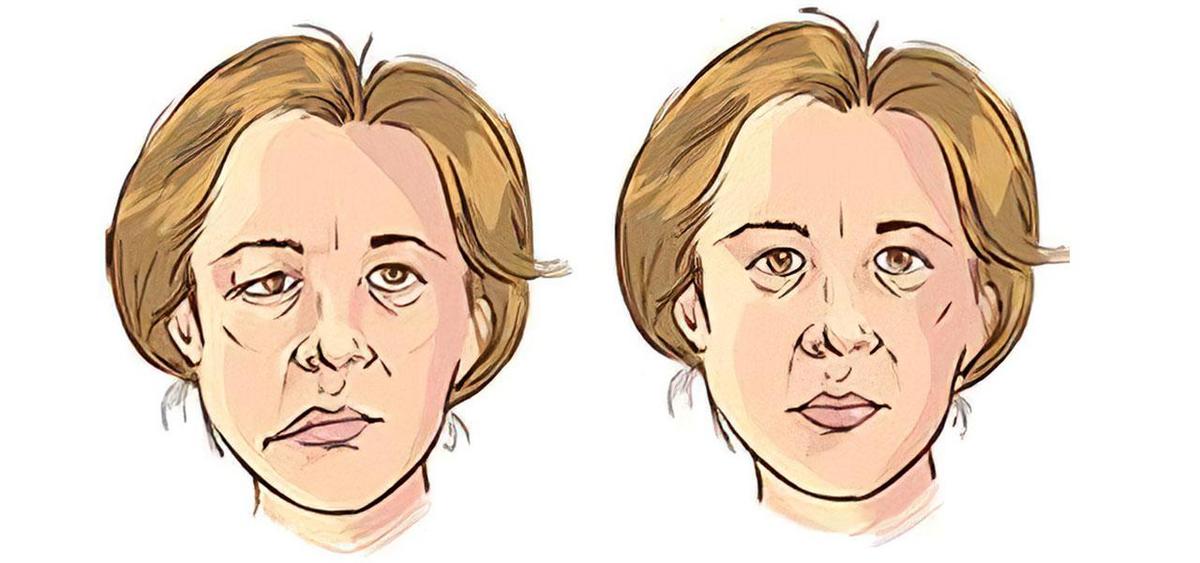TL;DR:
- Facial nerve palsy results from VII cranial nerve damage, leading to asymmetry, drooping mouth/eyelids, speech/sound perception issues, and impaired saliva/tear production.
- Symptoms include facial asymmetry, inability to blink/whistle/blow, drooping eye corners, numbness, hypersensitivity to sounds, and trouble brushing teeth or tasting.
- Treatment options:
- Pharmacology, exercise, and massage (first line).
- Laser therapy stimulates nerves and promotes regeneration.
- Light therapy (infrared) aids regeneration and prevents tissue overheating.
- Aptos Threads lift drooping features (e.g., lips/eyes) with minimally invasive results visible quickly.
- Nerve transplantation/transposition reconnects or replaces damaged nerves but is reserved for severe, permanent cases.
- Treatment is tailored to each patient’s condition.
People who have undergone a stroke often struggle with facial nerve palsy. As a result of it, facial nerve paresis occurs and the appearance of the face changes. Modern aesthetic medicine makes it possible to effectively combat the stubborn effects of stroke and facial nerve palsy. So how is this type of ailment treated and what is worth knowing about its formation?
What is facial nerve palsy?
The facial nerve palsy is referred to when the VII cranial nerve is damaged. When damage to the VII nerve occurs on the face, paresis and asymmetry may appear. Each patient diagnosed with facial nerve palsy may have slightly different symptoms. All because the VII nerve is responsible for both facial expressions of the mouth, eyelids and controls the secretion of tears and saliva. Therefore, one patient may have a drooping corner of the mouth, and another may have a drooping eyelid, which make facial asymmetry appear. In addition, facial nerve palsy can contribute to problems with correct pronunciation and the perception of sounds. Usually, the paralysis affects only one side of the face. Facial asymmetry and the causes of its occurrence are quite numerous, but the most common include stroke or inflammation of the brain.

Symptoms of facial nerve palsy.
Facial nerve palsy produces characteristic symptoms, as patients usually develop an unsymmetrical face. A paresis follows, which can progress significantly over 48 to 72 hours. Often patients complain of a feeling of numbness and heaviness in the part of the face affected by the paralysis. The main symptoms of facial nerve paralysis are:
- drooping of the corner of the eye,
- inability to make facial movements of the mouth,
- problem with blinking,
- impaired saliva production,
- inability to brush teeth,
- disturbance in the perception of tastes,
- hypersensitivity to sounds,
- loss of the ability to whistle or blow.
Symptoms of facial nerve palsy In some cases, asymmetry of the eyebrows and asymmetry of the cheeks also appear. The symptoms of facial nerve palsy may disappear on their own after a few weeks. If this does not happen, treatment is necessary to help combat the annoying discomfort and lack of facial symmetry.
How is facial nerve palsy treated?
Treatment of facial nerve palsy usually begins with pharmacology. Regular exercise and massage are also important. If these methods do not work, aesthetic medicine treatments are resorted to. These include:
- laser therapy,
- phototherapy,
- treatments that remove asymmetry,
- facial nerve transplantation,
- nerve transposition.
The choice of treatment method is selected individually to the patient’s needs – after an extensive history.
Laser therapy and light therapy.
Laser is an excellent tool for stimulating the nerve. This method of treatment is most effective in the first days after the onset of facial nerve palsy. It involves irradiating zones of special interest with a laser beam. These include the area of the rhino-nipple fissure, the upper cervical sympathetic ganglion, the area of the quadriceps-acetabular muscle and the paralyzed facial muscles. On the other hand, light therapy, thanks to infrared radiation, allows nerve regeneration and prevents overheating of tissues in the acute state.
Treatments to remove asymmetry
Among the most commonly performed procedures to remove facial asymmetry is Aptos Thread treatment. This is a minimally invasive procedure that achieves a lifting effect. This means that a drooping lip or corner of the eye can be lifted just by using the threads. The procedure involves inserting threads under the skin of the face, which lift the drooping skin according to marked lines. Therefore, before the procedure, the doctor carefully plans with the patient the effects and the course of the threads. The effects are visible practically immediately after the procedure is performed. Facial asymmetry largely disappears, and after 6 weeks the full effects are visible.
Facial nerve transplantation and nerve transposition.
Other treatments while a patient has an asymmetrical face caused by facial nerve paralysis include transplantation and transposition of this nerve. Such treatment is used in cases of permanent damage to the facial nerve. Facial nerve transplantation involves transplanting other muscles with which the patient will be able to perform facial movements. Nerve transposition, on the other hand, involves connecting the damaged nerve to another nerve that is fully functional. This allows the patient to regain facial dexterity to some extent. Transplantation and nerve transposition are invasive procedures, so they are carried out only in justified cases, when previous treatment has failed.
Conclusion
Facial nerve palsy, often caused by strokes or brain inflammation, disrupts symmetry and affects daily functions. While symptoms like drooping eyelids, impaired taste, and numbness vary, they significantly impact quality of life. Treatment options range from medication and therapy to laser therapy and surgical interventions like nerve transplants. Each approach addresses specific needs, aiming to restore function and appearance. Modern techniques, including minimally invasive procedures, offer hope for recovery. Acting quickly and consulting a specialist is key to managing this condition effectively and making progress toward a more symmetrical, functional face.






